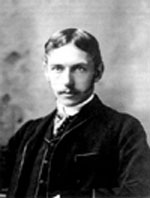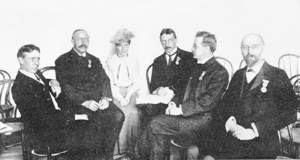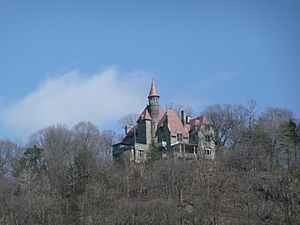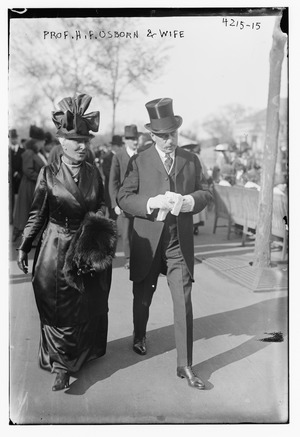Henry Fairfield Osborn facts for kids
Quick facts for kids
Henry Fairfield Osborn
|
|
|---|---|
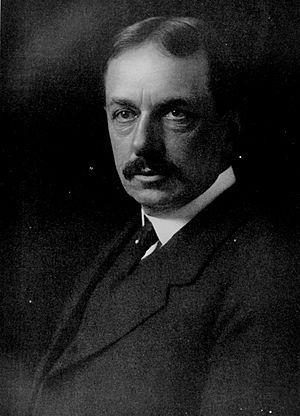 |
|
| Born | August 8, 1857 |
| Died | November 6, 1935 (aged 78) |
| Alma mater | Princeton University |
| Spouse(s) |
Lucretia Thatcher Perry
(m. 1881; |
| Children | 5 |
| Awards |
|
| Scientific career | |
| Fields |
|
| Institutions | American Museum of Natural History |
| Doctoral students | William King Gregory |
| Signature | |
 |
|
Henry Fairfield Osborn (August 8, 1857 – November 6, 1935) was an American scientist. He was a paleontologist, who studies fossils, and a geologist, who studies Earth's rocks and history. He was also the president of the American Museum of Natural History for 25 years.
Contents
Early Life and Learning
His Family Background
Henry Fairfield Osborn was born in Fairfield, Connecticut on August 8, 1857. His father, William Henry Osborn, was a very successful businessman. His mother was Virginia Reed Osborn.
Henry's family had many important people. His grandfather, Jonathan Sturges, was a well-known New York businessman. His aunt, Amelia Sturges, was the first wife of the famous banker J. P. Morgan. Henry also had a younger brother, William Church Osborn, who later became president of the Metropolitan Museum of Art.
His College Years
From 1873 to 1877, Osborn studied at Princeton University. He earned a degree in geology and archaeology. There, he was taught by a famous paleontologist named Edward Drinker Cope.
Later, Osborn studied anatomy in New York. He also went to Cambridge University in England. There, he learned about embryology (how living things develop) and comparative anatomy (comparing body structures). His teachers included famous scientists like Thomas Henry Huxley.
In 1880, Osborn received his science doctorate in paleontology from Princeton. He then taught biology and comparative anatomy at the same university until 1890.
Osborn's Career in Science

In 1891, Osborn started working at Columbia University as a professor of zoology. At the same time, he joined the American Museum of Natural History in New York. He became the curator of a new department for vertebrate paleontology. This department focused on fossils of animals with backbones.
Hunting for Fossils
As a curator, Osborn built an amazing team. His team included skilled fossil hunters and preparators. Some famous members were William King Gregory, Roy Chapman Andrews, and Barnum Brown. Barnum Brown was even called Mr. Bones! This nickname might have inspired the character Indiana Jones.
Osborn was also a member of the United States Geological Survey. He became a senior paleontologist there in 1924. He led many trips to find fossils in the American Southwest. His first trip was to Colorado and Wyoming in 1877.
He even studied Tyrannosaurus brains. He used a diamond saw to open fossilized braincases. Today, scientists use special scans and 3D software to study them without harm.
In 1908, Osborn became the president of the museum's Board of Trustees. He served until 1933. During his time, he helped the museum gather one of the best fossil collections in the world. He also led the New York Zoological Society from 1909 to 1925.
Discovering New Dinosaurs
Osborn was elected to the American Philosophical Society in 1886. He won many awards for his work in paleontology. In 1901, he became a Fellow of the American Academy of Arts and Sciences.
He named several famous dinosaurs:
- Ornitholestes in 1903
- Tyrannosaurus rex and Albertosaurus in 1905
- Pentaceratops in 1923
- Velociraptor in 1924
In 1929, Osborn received the Daniel Giraud Elliot Medal. This award came from the National Academy of Sciences.
His Work at the American Museum of Natural History
Osborn's biggest impact was at the American Museum of Natural History. He was great at managing science projects. He pushed the museum staff to create amazing displays. Because of him, the museum became a top place for exhibitions in the early 1900s.
The museum's murals, habitat dioramas (scenes with animals in their natural homes), and dinosaur skeletons attracted millions. Other museums copied his ideas. However, his focus on exhibits sometimes upset scientists who wanted to do more research.
Osborn also held some beliefs about human groups that are now seen as very wrong. He tried to include these ideas in the museum's exhibits. This troubled many people at the time and has affected how he is remembered.
Osborn's Scientific Ideas
Dawn Man Theory
Osborn had his own idea about how humans evolved. He called it the "Dawn Man Theory." This idea was based on a fossil discovery called Piltdown Man. At the time, scientists thought Piltdown Man was very old.
Osborn believed that humans and apes came from a common ancestor. But he thought they developed separately for a very long time. He argued that this common ancestor was more human-like than ape-like. He wrote in 1927 that when an early human ancestor was found, it would be "surprisingly pro-human."
Some people misunderstood Osborn's ideas. They thought he meant humans did not evolve from earlier life forms at all. This made him very frustrated.
Ideas on Evolution
Osborn first supported a theory called neo-Lamarckism. This idea suggested that animals could pass on traits they gained during their lives. But he later changed his mind.
He became a supporter of "organic selection," also known as the Baldwin effect. This idea suggests that learned behaviors can influence evolution over time.
Osborn also believed in orthogenesis. This is the idea that evolution moves in a straight line towards a goal. He even created his own term, aristogenesis, for his theory. He thought that new traits came from special "biomechanisms" in an organism's genetic material. He believed that random changes (mutations) and natural selection did not create new things in evolution.
Views on Human Differences
Osborn was one of the founders of the American Eugenics Society in 1922. At that time, some people from wealthy families believed that a person's traits were mostly decided by their family background, not by their environment.
Because of this, Osborn believed that different human groups had fixed traits. He thought that the "Nordic" or "Anglo-Saxon" group was the best. He supported eugenics, which was a movement that aimed to improve the human population by controlling who could have children. This was done to preserve what they considered "good" family lines.
He supported a book called The Passing of the Great Race by Madison Grant. Osborn wrote parts of the book's introductions. This book promoted these ideas about human groups and was even influential on Adolf Hitler.
His Personal Life
In June 1881, Osborn married Lucretia Thatcher Perry. She was a writer and came from an important family. They had five children together, but one child died when very young.
- Virginia Sturges Osborn (1882–1955)
- Alexander Perry Osborn (1884–1951)
- Henry Fairfield Osborn Jr. (1887–1969), who became a naturalist and conservationist.
- Josephine Adams Osborn (1890–1976)
- Gurdon Saltonstall Osborn (1895–1896)
After his father passed away in 1894, Osborn inherited his family home, Castle Rock. This large house was in Garrison, New York, overlooking the Hudson River.
His wife, Lucretia, died in August 1930 after being sick for almost a year. Henry Fairfield Osborn died suddenly on November 6, 1935, in his study at Castle Rock.
Animals Named After Osborn
Two animals were named in honor of Henry Fairfield Osborn:
- The dinosaur Saurolophus osborni was named by Barnum Brown in 1912.
- An African dwarf crocodile, Osteolaemus osborni, was named by Karl Patterson Schmidt in 1919.
Books He Wrote
- From the Greeks to Darwin: An Outline of the Development of the Evolution Idea (1894)
- Present Problems in Evolution and Heredity (1892)
- Evolution of Mammalian Molar Teeth: To and From the Triangular Type (1907)
- Men of the Old Stone Age: Their Environment Life and Art (1915)
- The Origin and Evolution of Life (1916)
- Men of the Old Stone Age (1916)
- The Age of Mammals in Europe, Asia and North America (1921)
- Evolution and Religion (1923)
- Evolution And Religion In Education (1926)
- Man Rises to Parnassus', Critical Epochs in the Pre-History of Man (1927)
- Aristogenesis, the Creative Principle in the Origin of Species (1934)
See also
 In Spanish: Henry Fairfield Osborn para niños
In Spanish: Henry Fairfield Osborn para niños
- "The New Museum Idea"


